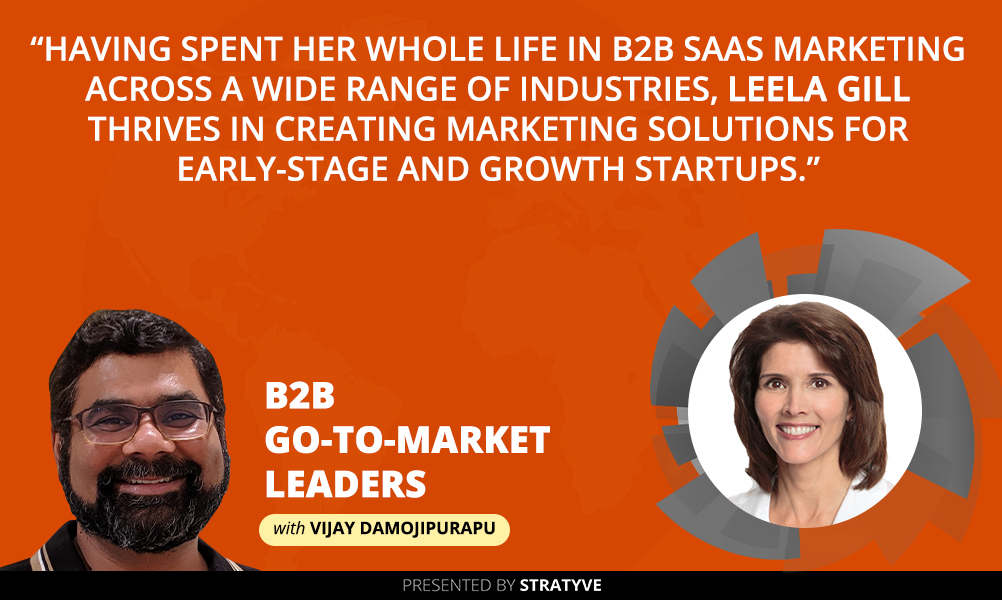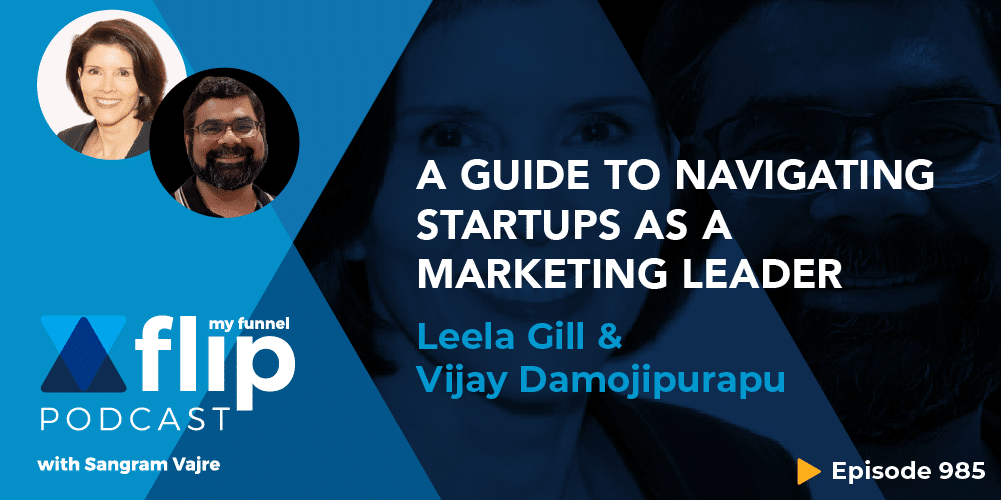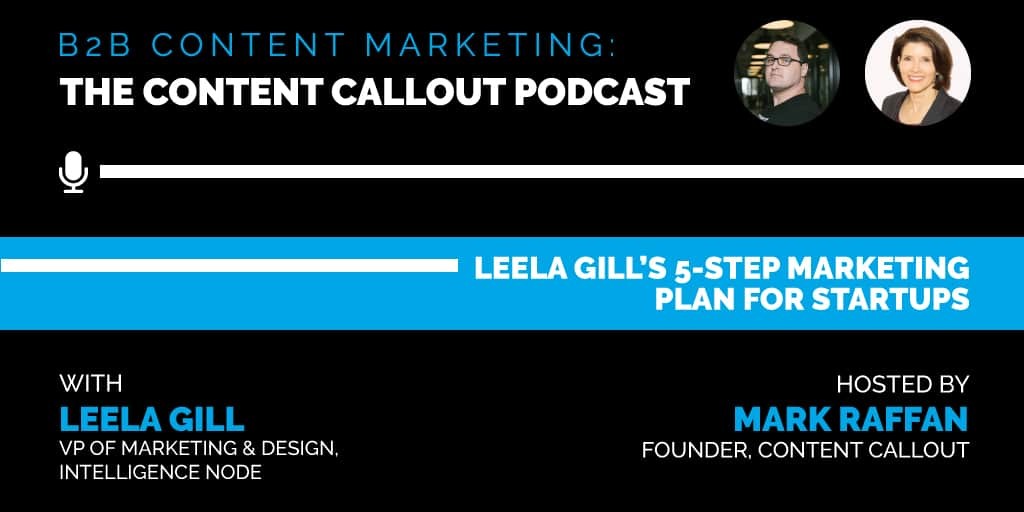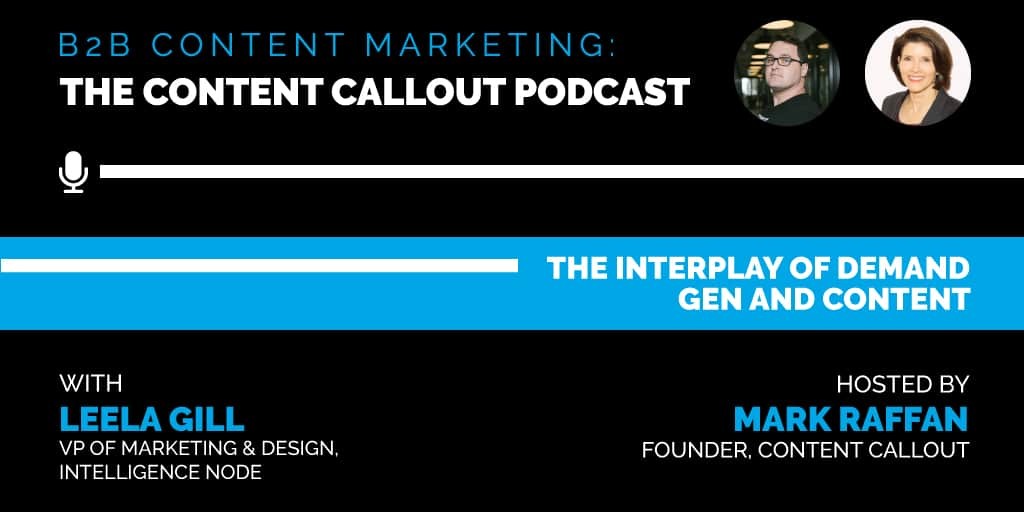SEO and other full-funnel strategies may get you the most leads, but a more targeted approach in marketing is needed if you’re looking to catch the big fish. When it comes to targeted approaches, account-based marketing trumps everything else. Leela Gill, the VP of Marketing at Intelligence Node, specializes in this space and has a track record of delivering this strategy in the B2B SaaS marketing space. For her, account-based marketing is simply Marketing 101. Listen in as she joins Vijay Damojipurapu on the show to explain how this strategy works and how she engages her marketing team at Intelligence Node to deliver the best results at a faster rate.
Thriving In B2B SaaS Through Account-Based Marketing With Leela Gill
In this episode, I have Leela Gill. She is the VP of Marketing at Intelligence Node. She’s got a solid track record of diverse experiences across sales and marketing and leading those functions at startups. Leela’s main expertise and track record is around account-based marketing and selling to big brands like Walmart, Home Depot, Lockheed Martin. Leela, I also looked up your background. It seems like you got some good exposure and experience in M&A, change management and fundraising. A lot of topics and a lot of ground for us to cover here. Welcome, Leela.
Thank you. I’m happy to be here, Vijay.
The first question I have for all my guests is how do you define go-to-market?
I define go-to-market as the approach that you’re going to take with your marketing sales and channel partners to deliver your unique value proposition to prospects and customers. There are multiple approaches and multiple activities around go-to-market strategies. You have a go-to-market strategy for your corporation or your business, and you should have a go-to-market strategy for product launches. The ways that you approach marketing sales and channel partner sales in selling to your prospects and to your customers are the go-to-market approach.
It’s funny you say that. I agree with both views of the go-to-market. Early on in my career, I was more in the product marketing track. My view of the go-to-market was the upcoming launch for the product and that’s about it. Line up and essentially worked closely with the product, with other teams within marketing, with sales and sales enablement, even customer support and customer success teams. That is my view of go-to-market back then. Since then, I have evolved my thinking. That leads to the first point which you mentioned that it is not about the upcoming product launch, but it goes much and far beyond that.
I work with early-stage and growth companies. You do have to step back and think about your go-to-market from a company perspective. Where do you fit into the category? Are you creating a new category? What’s the ideal customer profile that you’re going after the persona and all those elements that go into a GTM strategy?
You mentioned a couple of things. One is the personas and the ideal customer profile. You’re also looking at the buyer’s journey, not just the seller’s or sales’ journey. How often typically do you do that or would you push your teams to do an update to the personas?
First, I want to back up and explain what I do as foundational work with my go-to-market strategy. There’s some foundation work that needs to be done around your vision and your mission. I believe it’s important to develop a purpose-driven organization so that inspires people. A lot of people don’t recognize this, but we make decisions emotionally. We use the logical side of our brain, the left side of our brain to justify those emotional decisions. We come up with the ROI. Having a purpose-driven organization with a vision and a mission that resonates with human beings is super important. On top of that foundation is honing in on your ideal customer profiles and your personas. That’s the foundational work and then developing the strategic messaging architecture on top of that. Beyond that, understanding where you are relative to your competition, and then you get into the more micro details around pricing strategy and sales and marketing alignment.

Your approach is completely validated by the market leaders out there, which is you need to lay out all those foundation elements and then continuously assess what pieces do you need to change or update. Do you do that on a quarterly basis or annual basis? I’ve seen it fall in all ends.
Going back to your point about timing, we set the strategy on an annual basis, but we have a quarterly cadence that we put into play that allows us to do a check step, a continuous improvement step. We don’t necessarily go restructure the foundation, the mission, the vision and the foundational work. We don’t redo that. As an early-stage company, you do have to check that and refine, especially on the personas because if you’re going in and you don’t understand your personas well, then you need to be constantly going out there and talking to them and understanding what their pain points are and what drives their decision-making. With that said, we put a strategy together for the year, and then we certainly check steps in a quarterly cadence.
The go-to-market topic and the various topics around it are so diverse. We easily got pulled early in this conversation. Let’s step back a bit, Leela. For the audience, can you share a bit about your personal journey as well as your professional milestones? What do you do at Intelligence Node and what your focus areas are?
I turned marketing operations professional and leader after school. My first job out of school was with a multi-billion-dollar engineering company. I started out in engineering, and then ended up running a very large manufacturing plant. That’s a whole other episode on the first woman that runs a multimillion-dollar manufacturing plant for this company. Beyond that, what I like to tell people is that I’ve spent my whole adult life doing B2B SaaS marketing. My background is I’ve sold into the FinTech sector, the green tech sector, the retail tech sector, and the HR tech sector. It is a wide range of industries in all B2B SaaS marketing. I thrive with early-stage and growth companies. That’s where I get excited because there’s a real creative process there that has to happen. You also have to be courageous. Those are two of my core values, being creative and courageous. In those growth companies, there are lots of highs and lows and I liked that excitement.
Would you say that your core values as creative and courageous are what pulled you or shifted your journey from manufacturing engineering to early-stage B2B marketing?
Yes. Both of my parents were engineers, so I felt like I was destined to go on that path. Later in my life, I realized I’m more on the frontend of the business. I like interacting. I love working with the sales team. I love being in front of people and understanding them. I jumped over to that side of the road. Beyond my work profile, I live in San Francisco. I am a mother of two teenagers and my husband is completely opposite of me. He’s a social worker in the nonprofit world. I work in a for-profit world. He does a lot of amazing work for our communities. I’m very active in my community as well as a leader.
That’s a way to lead a more meaningful and purposeful life. It is not about work or making money, but contributing the society as a whole. I was trying to hit a point earlier, which is you realize that rather than you living a life defined by your parents, where they are engineers and you by default went into engineering, slowly over time, you realized, “That’s their life. If I’m doing engineering, I am living their version of my life versus my version of my life.”
I think back to when I was growing up, that’s what a lot of kids or young people did. I am happy about this generation of young people that are coming up because I don’t think they follow the same ground rules. They’re searching now for what’s important to them. They’re vocalizing the importance of particular things in our economy and our culture that are important. I’m delighted that the young people are coming into their own quicker and taking their power seriously while they have the ability to influence.
While on the topic of young people, how do you describe what you do at work to your kids? With those teenagers, they get a sense of what you do.
I do test my children to find out if they know what my title is. They do know my title. They do know that I work in marketing for a software company in the retail industry so I would check those boxes. I think that’s good, but I am digging into it. I don’t know that they understand what marketing is. The older one is in college. He’s starting to learn what marketing is so we have some fun conversations about that.
I continue to have these conversations with my kids as well, two boys. I educate them on what marketing is in their own terminology. Back in the days when Toys “R” Us was still around, I used to portray that as marketers do the stuff, which pulls you into getting your parents to buy the toys for you.
That’s a good description. That’s a great age group too. I love that age.
Building on our earlier questions around go-to-market and how you define go-to-market, back at Intelligence Node, you got a diverse set of responsibilities all the way from account-based marketing to field marketing, content, thought leadership and brand. What is your top 2 or 3 key go-to-market programs? How do you build your teams and give them direction in executing those?
There’s a lot packed into that question. I’ll start with our key programs. We have done a good job on organic SEO work. Before I came into the company, we got a lot of our leads through SEO and organic search, which was great. We continue to use that as the main strategy. We’ve also built on top of that an account-based marketing approach. My favorite quote or saying out there is, “Account-based marketing is a good marketing.” I do believe that. Account-based marketing makes you focus on who you’re trying to sell to, what is the value proposition, what are their pain points, and getting that messaging honed in. There’s also an element of timing. You’ve got to get in front of the right people at the right time and have a message that resonates with them. It sounds easy enough to describe, but it is tougher than you think, especially the timing element.
I think you hit it well. That’s what I used to wonder when this whole account-based marketing terminology and phrase started getting popular in the marketing world and even beyond years ago. As time went by, I started wondering, is this a new paradigm? If you deep dive below that acronym, it’s all about how do you understand your target people, customers and individuals? How do you understand them as human beings? What drives them and how do you get in front of them on an ongoing, but in a healthy manner? How do you stay in touch with them, and then help them see the value of what you do? If you peel that onion and go up level, it’s Marketing 101, nothing different.
It’s good marketing. For somebody, with my background in engineering, I like learning, digging in, getting data and understanding specifically who I’m selling to. I think that’s fun. Sometimes it’s hard, especially when you’re in growth companies, to take that time and to understand who your target market and your personas. If there’s any advice I’d give to people, it’s to make sure you understand your target market and your ideal personas because that is foundational work right there.

You also mentioned a couple of interesting nuggets over there, which is you do both inbound SEO, as well as account-based marketing. It’s two ends of the spectrum where typically inbound SEO, depending on our target market and customer base, is smaller sales cycles, smaller ACV account, Annual Contract Value or Annual Customer Value. That’s on one end of the spectrum. You’ve got the account-based marketing on the other end, which is more of longer sales cycles, bigger contracts, and longer-term commitments. How do you balance or what focus areas do you do? Is that an evolution that’s happened during the time? Are you shifting your market?
We are intentionally trying to shift to large enterprises more. We’re complementing our SEO strategy with targeted advertising using LinkedIn and Google retargeting ads to try to hone in on large enterprise. It’s true that SEO does bring in the smaller, mid-market companies for the most part. At least that’s been our experience. The mid-market is coming from the SEO leads that we’re finding people are searching for us and finding us. To complement that, we are doing a lot of work on LinkedIn and doing targeted advertising, targeted email campaigns, coming up with a target list of accounts, and reviewing that with our sales team, and making sure we’re aligned. We have in our tech stack of content delivery platform that personalizes to the company that’s coming in, adds a logo, adds the company name, does some text changes around that particular mission. We complement the SEO approach with this targeted marketing approach.
You mentioned one of the best practices, which I keep sharing with my clients. If you’re shifting to more account-based marketing, you also need to keep in mind the tech stack. For the benefit of the audience, would you mind sharing the details of the tech stack?
It starts with HubSpot. We’ve made a strategic decision. We were on HubSpot and Salesforce. For our company where we are in the cycle, we decided to migrate everybody over to HubSpot. It’s more intuitive. We don’t have a super large sales team, so it was the right tool. That was one of the most important decisions we’ve made because the syncing between HubSpot and Salesforce can cause issues. We are on HubSpot as our marketing automation and CRM tool. On top of that, we are using some tools for lead enrichment, Seamless.ai and LeadGenius. We use those two in different cases for those lead enrichment tools. Before that, we have intent data, which is critical. We’re using Bombora for intent data. On top of that, we’re using a content delivery platform called Folloze.com, which does the personalization on smart boards. That’s our tech stack. We have a lot of tools around that like SEMrush for SEO. We have lots of other little tools. We’re using some tools for conversion within LinkedIn. We’ve got a chatbot and some other tools around that as well.
It is great to push your team around constantly testing with a channel, doing several experiments around personalization, A/B testing and so on.
HubSpot is great because it allows you to do that A/B testing on your emails. They’ve also launched a target accounts module so you can identify your target accounts in HubSpot. You can hone in on whether how long they’re on your website. It gives you a little bit more focus on that account-based marketing program that you’re implementing.
Building on top of the tech stack as well as the account-based marketing, you also are a committed person in thought leadership. That’s something that I’ve seen where you publish on Forbes and several other industry publications. What are your thoughts if someone wants to build a thought leadership program? What is your advice and what did you tell them?
Thought leadership is about brand development.
Would you say both brand development for the company as well as brand development for an individual? They go hand-in-hand.
It depends on what you’re talking about. In one case, it might be about your products in the marketplace. With Intelligence Node, for example, we sell to retailers and brands. We talk about how we help them convert shoppers into buyers through the eCommerce buying journey. We have specific points that we interact with shoppers. We help retailers and brands become visible to shoppers and help them convert to buyers. We did a huge consumer buying behavior survey. It was a compilation of a lot of surveys that we started before COVID. We were doing the surveys consistently through COVID and we launched that report. We did a lot of thought leadership around that particular report because it’s a 40-page report packed with data.
We were doing podcasts, posts on social media, lots of email campaigns, and presenting at virtual round tables. That piece around, what are the consumers thinking now? You can’t do thought leadership unless you have a good topic that’s interesting to other people. From a company standpoint, you want to find what that information is. Present it in a way that’s easy to understand through multiple channels, and go into thought leadership with the idea that you want to educate. Thought leadership is not about selling. It’s about helping them understand. The same principles apply on a personal level.
That’s key, the points that you hit over there, which is it’s not about you trying to push a message or sell. It’s all about how you’re educating and showing the path forward and shifting their thinking. Are there ways in how you measure? I don’t know if there’s a way to measure thought leadership. I have not seen one. What is your view on that?
We measure it through share of voice, which is a metric that you can get. There are tools or PR firms out there that help measure it. It’s how many times you’re published or you’re out there in the media. We’re using their other metrics, but that’s the metric that we use mostly. Impressions, how many eyeballs did you get, those are the starting point. On top of that, the share of voice and engagement are important measures. On your social media, how many people are interacting with you? Beyond likes, are you getting commentary? Are you getting a good, healthy dialogue? That’s a metric that we use.
At some point in time, I would assume that your prospects or your buyers would mention about so-and-so article when you are in the middle of a sales conversation. Would you agree that’s one more way of measuring if your thought leadership is working?
We push a lot of our thought leadership out through our multiple channels as well. If we’re published in the New York Times, we’re going to send that out to our email list and we’re going to put it out on social media. We try to leverage that as much as possible. We can track through UTM codes and things like that where leads are coming from based on thought leadership pieces that we’re putting out there.
Let’s shift to focus to 2021, which is almost around the corner for all of us over here. These months have been crazy. As I speak to the go-to-market leaders, the general message and the sense is, several of the teams have adjusted well. At the same time, there is a complex factor that the leaders have to watch out for and ensure that the teams are not falling into the complacency bucket. From your viewpoint for you and for Intelligence Node going into 2021, what do you see as the key challenges? For you as a leader, what are you going to push your team on?

In complacency, the status quo is not going to work. We all know that we have to drive revenue faster. My biggest challenge is trying to move us faster. It’s a balance because you don’t want to move so quickly that you’re not doing things correctly or completely. We put project plans together on everything that we’re putting out there. We give ourselves dates and we hold ourselves accountable to those dates. I try to be a positive leader that reinforces the good things that we’re doing. If we’re slipping on things, going back to the purpose-driven organization, I focus and remind people why we have to do this. The challenge is, how do you accomplish things faster? My answer to that would be to be focused, be intentional on what programs you’re going to run. Don’t spread your resources so thin that you’re trying to do ten different things at the same time. I’ve learned that you need to execute. To do that, you have to get focused and keep the team delivering on a timeline that’s acceptable to your company.
How big is the marketing team and what are the different functions that you have with them?
We have under ten people. We have SEO. We have somebody that’s focused on paid. We have email and social as our marketing ops person. He’s also responsible for data hygiene, which is an important one. I also have the design team reporting to me. That’s the design team not only for marketing collateral but also for our product or UI, the user experience piece. I have a pretty solid foundational team. I have a content marketing person as well. We do use a PR agency to help us as well.
You also mentioned that as a company at Intelligence Node, you’re investing more into account-based marketing. How do you build that alignment and seamless transition from marketing, generating leads to handing off SDR team? Do the AEs do that? How is that laid out?
I call that sales and marketing alignment. We have a meeting every week with the ABM project manager, my ABM marketing lead, and I meet with the SVP of Sales every week. We go through all the leads. Marketing does its homework before this meeting. We make sure we look at the leads that came in for the week. We make sure that they’re clean. We have all the information about them. We then go into the meeting. We have an automated email process where the lead should book a demo with the SVP. If that doesn’t happen, we have a process where we’re trying to follow up with the lead. We discuss those particular leads where they wanted to have a demo like, “Did we get the demo booked? Yes or no? If not, here’s the strategy we want to take with this particular account.” That’s a new behavior as well for us at Intelligence Node. That’s been helpful. We got some good accounts in our pipeline that we’re working through because of that process. I can’t underscore how important sales and marketing alignment is in account-based marketing. Marketing cannot do it without sales. You have to go after the right target list.
If someone were to ask me who is the number one customer for marketing, you have real customers. For me, as a marketing leader, it’s my sales team helping them win and get the revenue.
Especially for early-stage growth companies or for any company, especially when you’re trying to grow revenue quickly and survive out there in a recession through sales and marketing. The more aligned you are, the better you’re going to perform. We’re seeing that in Intelligence Node as well.
Continuing our discussion around how you’re thinking about the future, if you were to get a certain X amount of dollars, where would you invest and why?
I believe that the old adage content is king is still true. I would go after more ways to develop high-value content. I think that’s an important word.
How do you define high value?
It needs to be bringing something new to the marketplace, new insights. I would invest in that. We’ve been doing that through consumer surveys. We’ve been asking consumers directly about their buying behavior, especially as it’s converted from in-store to eCommerce and online. What’s driving them to go there, and their behaviors associated with shopping on mobile phones, laptops and things like that? Also, through research and surveys, and producing high-value content. I love the idea of a podcast. That would be a dream. I would love to start a podcast series as well.
It’s a cliché, content is king, but it’s been watered down a lot. People are wrongly or rightly, and not intentionally, but they produce any and all kinds of content without understanding. It goes back to the foundational elements, the buyer, the persona and the empathy factor. Are you listening to them and what they care about? You then build that content around them. This has been a great conversation, Leela. Thank you for sharing all the details. You’re doing some good stuff with Intelligence Node, and serving your retail customers. As we headed to our closing section over here, do you want to give a quick overview of Intelligence Node? What you do, who you sell to and what is your value prop?
At Intelligence Node, we are a retail analytics company that helps retailers and brands sell. Our slogan is, “We help retailers and brands convert shoppers into buyers.” Forrester broke down the revenue equation for retailers and brands to be, revenue equals visibility times conversion times price. What we do at Intelligence Node is we help on all three of those buckets. We help retailers and brands become visible to shoppers and getting them on the first page. If you’re not on the first page of Amazon, Alibaba, Google or Bing, you’re not visible. The next piece is conversion. We help retailers and brands understand how they can win a shopper’s attention.
You need to have the right product description. We have computer vision in our ML. We give retailers and brands advice on your missing attributes, your pictures don’t look as good. We give them product image scores and things like that. Conversion and on price, we give them information about whether they are competitively priced with their competition. We have rules-based pricing that helps them automate those pricing decisions. They don’t have to have any human beings going in there and changing the pricing. Our solution can help them change that price instantaneously. A little factoid that we throw out there about Amazon. There are millions of products on Amazon. They’re checking prices on those products every two minutes. They’re making adjustments every two minutes. Human beings can’t do that. It’s the age of AI, so retailers and brands must-have AI driven-machine learning solutions to help them with these decisions. That’s who we go after and that’s what we do.
Good luck to you and your team. One final question for you, if you are to shout out to 2 or 3 go-to-market leaders, peers out there in the industry, who do you call out? What are your resources? How you stay in touch and be up-to-date with all the go-to-market programs?
I try to spend at least 5% or 10% of my time benchmarking every week participating in webinars. There are lots of virtual round tables and conferences. In fact, I was participating in the B2B SMX Conference held by Demand Gen, which was good. It’s an ABM session. I am part of some CMO forums. I reach out to people and I say, “I want to benchmark with you about X, Y and Z.” Sangram Vajre at Terminus, he’s one of those ABM leaders that I admire. I follow him pretty closely and participate in the community forums that he set up.
The same here. I’ve been a big follower and fan of Sangram Vajre. I listen to this podcast and he’s been one of the pioneers around whole ABM. He, Jon Miller and then a few others. Even if you go and ask Sangram, and he said this many times, which is, “ABM is a new terminology or new phrase, but if you boil it down, it’s marketing 101.” Thank you for coming on the show, Leela. We had a fun conversation. Good luck to you and the team at Intelligence Node.
Thank you. Have a great day.
Related Posts:
Influencers, Brand Ambassadors and Raving Fans – and Why You Need All Three
For marketers, influencers, brand ambassadors, and raving fans can create a significant differentiator…
Marketing as a Revenue Generator and Catalyst for Change
Marketing is a change catalyst, calling customers to change and jump on, and it also helps the organization…
A Guide To Navigating Startups as a Marketing Leader
It can’t be understated: Being a marketing leader of a startup can be crazy and chaotic. Out of the million…
A 5-Step Marketing Plan for Startups
As a marketing professional working in a startup, do you know how to help your company grow revenue? How is…
Building A Diverse And Equitable Business: The Role Of Marketing
Jesse Jackson once said, “Inclusion is not a matter of political correctness. It is the key to growth.” This…
B2B Marketing: What We Can Do To Help Save The Planet
The COVID-19 pandemic is the biggest business challenge of a generation. Organizations scramble to establish…
The Interplay of Demand Gen and Content with Leela Gill
The COVID-19 pandemic is the biggest business challenge of a generation. Organizations scramble to establish…
Early-Stage Marketing: A Five-Point Leadership Framework
The COVID-19 pandemic is the biggest business challenge of a generation. Organizations scramble to establish…
Social Media: Getting Above the Noise
The COVID-19 pandemic is the biggest business challenge of a generation. Organizations scramble to establish…










